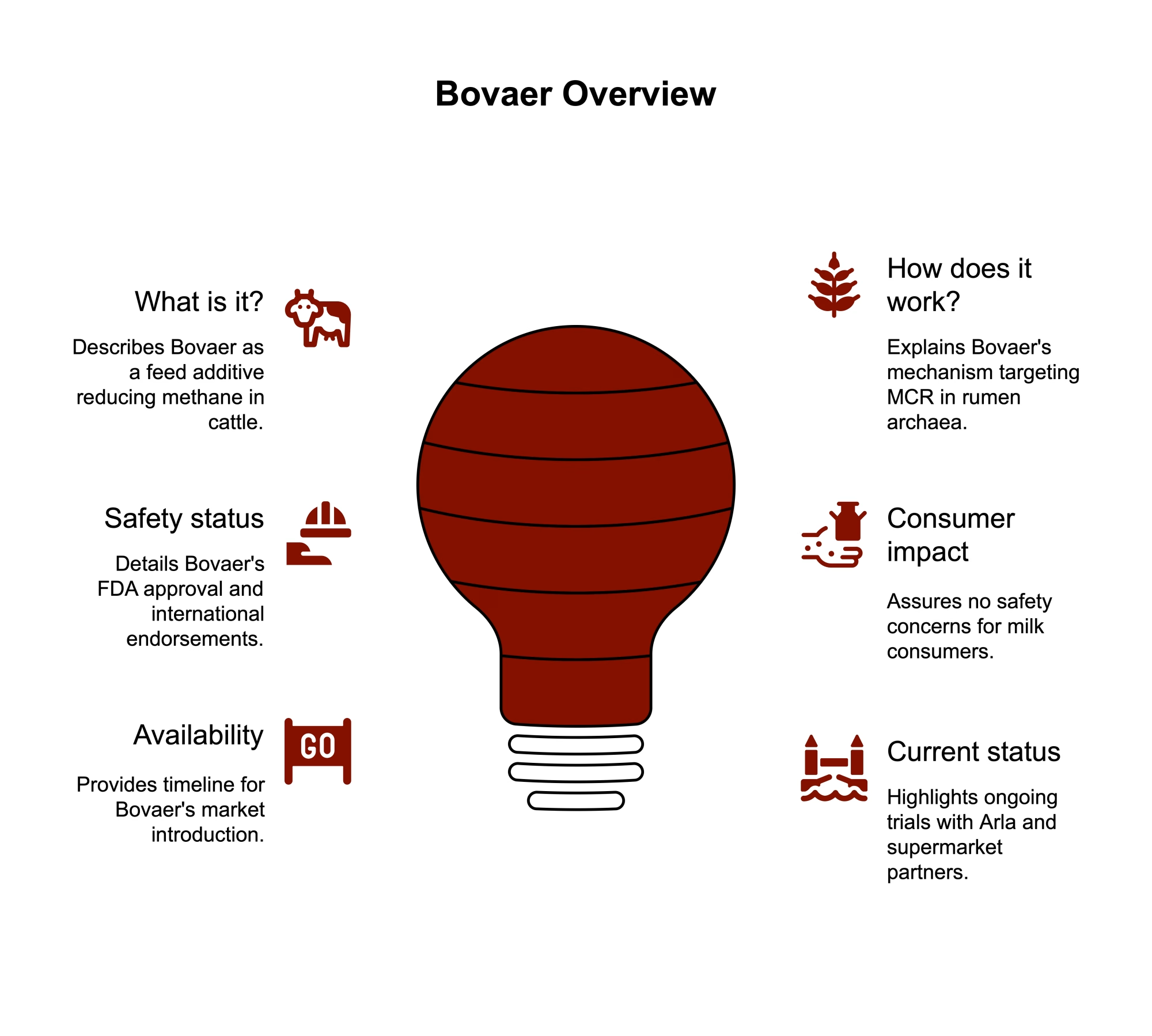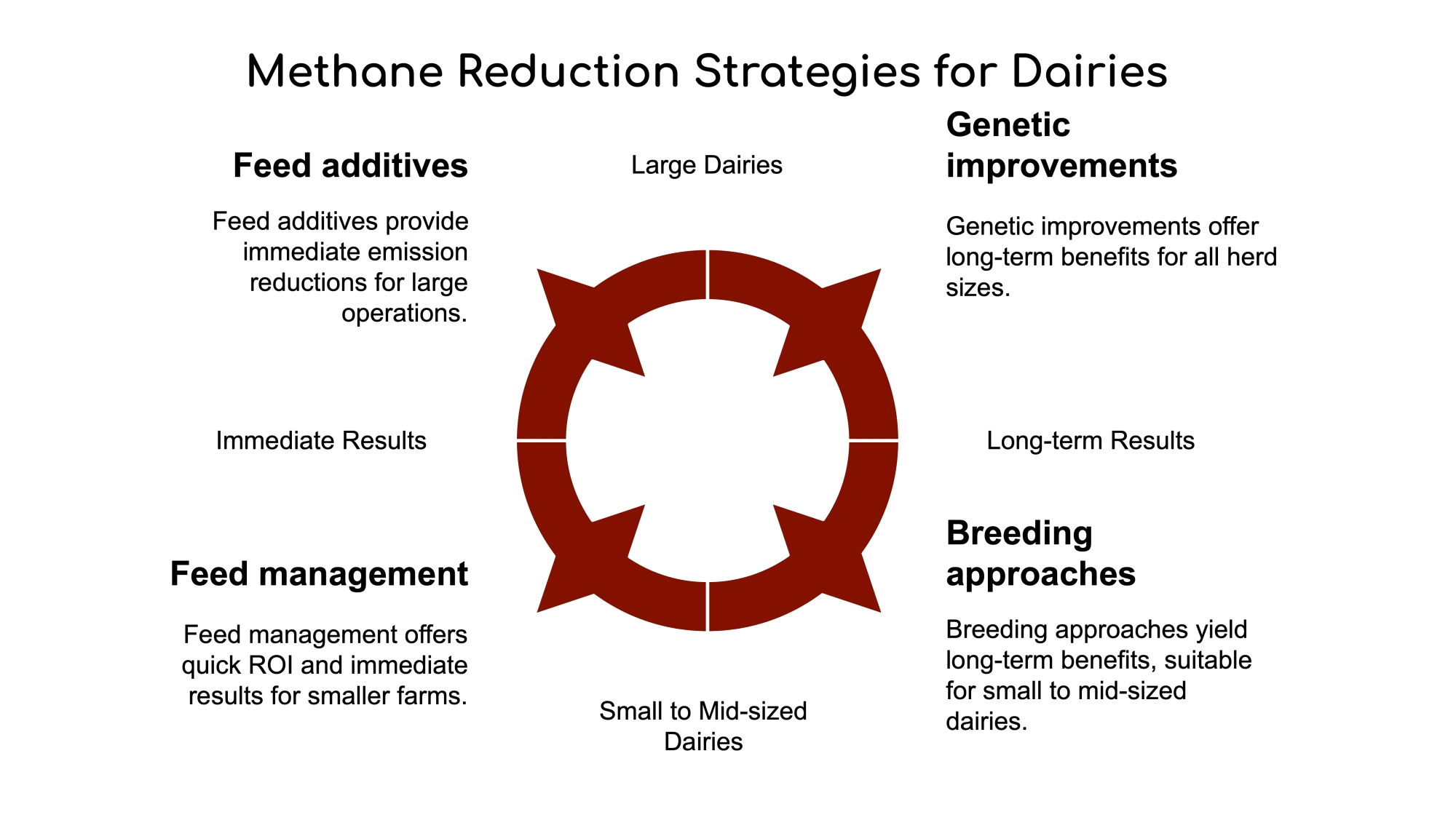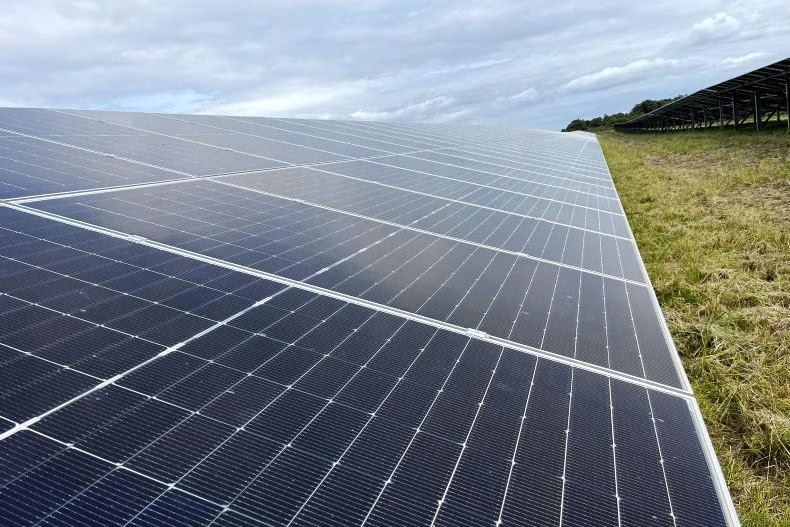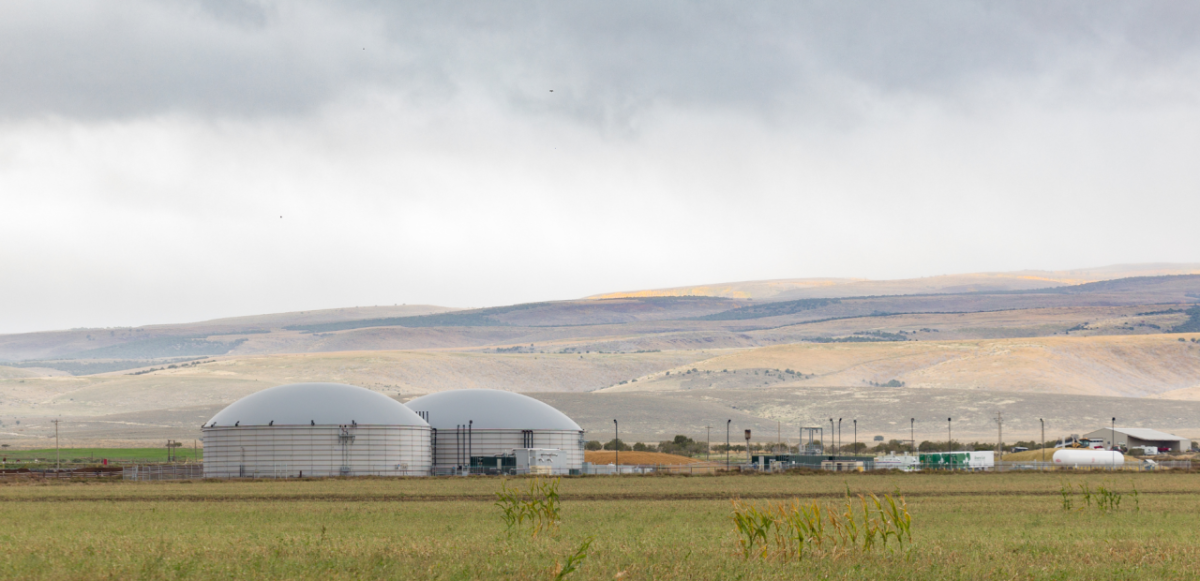Climate zealots call your cows climate criminals, but savvy dairy farmers are turning methane reduction into cold, hard cash. Here’s how they’re doing it.
The climate crusaders have dairy in their crosshairs, but savvy farmers aren’t waiting for the regulatory hammer to drop.
While environmental zealots paint cows as climate criminals, innovative producers are discovering that fighting methane isn’t just about appeasing the green lobby—it’s about boosting efficiency and padding the bottom line.
The FDA’s approval of Bovaer on May 28, 2024, a feed additive that slashes methane emissions by 30%, has sparked excitement and controversy. Farmers face a critical question as Arla Foods rolls out trials with supermarket partners: Can these methane-busting technologies deliver profits while silencing the critics, or are they just another expensive hoop for struggling producers to jump through?

What is it? 3-Nitrooxypropanol (3-NOP), a feed additive that reduces methane production in cattle
How does it work? Targets methyl-coenzyme M reductase (MCR) in rumen archaea to reduce methane formation.
Safety status: Approved by FDA (May 2024) and approved in Great Britain, EU, Australia, and Canada.
Consumer impact: There are no safety concerns for milk consumers—”The cows metabolize the additive so it does not pass into the milk.”
Availability: Expected in the U.S. market by the third quarter of 2024
Current status: In trials with Arla and supermarket partners in Great Britain
Dairy Diet Revolution: When Your Cow’s Feed Becomes Political

Bovaer Battles: Science vs. Social Media
The latest flashpoint in dairy’s climate wars isn’t happening in Parliament—it’s happening at your local grocery store and on social media.
Arla’s rollout of Bovaer has triggered a social media firestorm. Some TikTok users post videos of pouring milk down the sink, claiming they want to prevent Arla from profiting from their purchases.
“It’s essentially another anti-vaccine campaign,” says one online commenter. “People claim this feed additive is unsafe for humans when the science is clear. Bovaer has undergone extensive safety evaluations and received regulatory approval for use in dairy cattle.”
Bovaer (3-nitrooxypropanol or “3-NOP”) works by targeting methyl-coenzyme M reductase (MCR) in rumen archaea, effectively reducing methane production in the cow’s digestive system. According to Elanco Animal Health data, this equals approximately 1.2 metric tons of CO2e reduced annually per cow.
“Milk from cows given Bovaer, a feed additive used to reduce methane emissions, is safe to drink. The cows metabolize the additive so it does not pass into the milk.” — Food Standards Agency.
Despite thorough safety assessments by the FSA that concluded “there are no safety concerns when Bovaer is used at the approved dose,” concerns have been amplified by questionable social media content, with some posts attempting to link the additive to Bill Gates—a familiar tactic in anti-science campaigns.
“The term ‘additive’ has been associated with negativity for years,” explains one industry commentator. “When consumers hear chemicals and cows in the same sentence, they panic—even though milk naturally contains thousands of chemical compounds.”
According to extensive testing reviewed by the European Food Safety Authority, 3-NOP is not detectable in a cow’s plasma, milk, or other edible tissues because the animal’s stomach rapidly breaks it down into metabolites—primarily 1,3-propanediol—which is mainly exhaled as carbon dioxide.
Silage Strategy: The Quiet Methane Fighter

While Bovaer grabs headlines, innovative farmers quietly slash emissions with a less controversial approach: upgrading their silage game.
Higher digestibility forage means less fermentation time in the rumen, which translates to fewer burps and more milk per ton of feed.
It’s about energy efficiency as much as environmental impact. Every methane molecule represents lost energy that could have gone into milk production.
“Protein content is the whole ballgame,” explains nutrition specialist Tom Wilson, a Yorkshire dairy farmer participating in emission reduction trials. “Young grass with high digestibility can dramatically reduce methane output, but you’ve got to balance the nutrition carefully.”
Better Breeding: Engineering Tomorrow’s Low-Emission Cow

Third-generation Wisconsin dairy farmer Pete Larson used to select bulls based solely on milk components and conformation. Today, he’s pioneering a different approach: breeding cows that naturally produce less methane.
“We’ve identified significantly more gas-efficient bloodlines,” Larson explains, showing off his sleek, compact Holsteins. “Smaller frame, same production, less feed, less methane—it’s not rocket science, it’s just smart breeding.”
Larson’s 350-cow operation has been working with his genetics provider on selecting bulls that produce daughters with better feed efficiency. “After implementing targeted breeding strategies for four years, our feed costs have dropped approximately 8% while maintaining milk production. The methane reduction is a bonus positioning us well for future market requirements.”
Researchers from the University of Pennsylvania School of Veterinary Medicine have confirmed what innovative farmers discovered through trial and error—low-emitting cows tend to be smaller and house different microbial communities, and these differences were not associated with reduced milk production.
“Low methane emitters are more efficient cows,” said Dr. Dipti Pitta, associate professor at the University of Pennsylvania School of Veterinary Medicine. “Methane formation is an energy-inefficient process, so reducing methane production gives that energy back to the cow for metabolic activities including improved growth rate and milk production.”
“We’re taking control of the narrative. Instead of waiting for regulations to crush us, we’re solving the problem ourselves and making more profitable cows.” — Pete Larson, Wisconsin dairy farmer.
Overcoming Obstacles: Real-World Implementation Challenges
Despite the promising potential of methane reduction technologies, dairy farmers face legitimate hurdles in implementation.
“The upfront costs of feed additives like Bovaer remain a concern for many producers,” explains Dr. Frank Mitloehner, Professor and Air Quality Extension Specialist at UC Davis. “Without processor premiums or carbon market access, producers must carefully evaluate the return on investment.”

Industry analysts point to several common barriers:
- Initial implementation costs without immediate financial returns
- Integration complexities with existing feeding systems
- Market uncertainty around carbon credit pricing
- Consumer acceptance of new technologies
The good news? Early adopters are finding these barriers surmountable. “We started with a small test group to minimize upfront costs,” explains Larson. “This allowed us to document benefits before scaling up. The key is starting small and expanding as you see results.”

Processor Power: How Milk Buyers Are Driving Change
Cooperatives and processors are quickly becoming key players in the methane reduction ecosystem. As Nestlé, Danone, and other major dairy buyers set ambitious carbon reduction targets, they’re developing incentive programs for producers.
Dairy Farmers of America (DFA), the largest U.S. dairy cooperative, has launched sustainability programs to help its 12,500 family farm owners reduce environmental impact while improving profitability.
“We’re working with partners across the value chain to develop incentives and support systems for our members who implement climate-smart practices,” explains Jackie Klippenstein, Senior Vice President of Government, Industry and Community Relations at DFA. “Our Gold Standard Dairy Program helps producers document their sustainability efforts and prepare for future market opportunities.”
Processors are increasingly linking sustainability to market access. Land O’Lakes’ Truterra sustainability program connects farmers with buyers willing to pay premiums for verified sustainable practices, creating financial incentives for methane reduction.

Methane Reduction Arsenal – Battle-Tested Solutions
| Strategy | Methane Reduction | Implementation Timeline | Additional Benefits |
| Feed Additives | |||
| Bovaer (3-NOP) | Up to 30% | Available Q3 2024 | 1.2 metric tons CO2e/cow/year |
| Diet Management | |||
| Young/Digestible Grass | Up to 30% | Seasonal/Immediate | Improved feed efficiency |
| Maize Silage Increase | 5-10% | Next harvest | Improved nitrogen efficiency |
| Breeding Approaches | |||
| Methane-Focused Genetics | Up to 22% | Long-term/Requires program | Maintains production levels |
| Safety Assurance | |||
| Bovaer in milk/meat | “No residues detected in milk or tissues” | “Additive is metabolized by cows” | “No safety concerns” |

Natural Solutions: Alternative Approaches to Methane Reduction
While synthetic additives like Bovaer face consumer resistance, other interventions are gaining traction among organic producers looking for natural approaches to emission reduction.
“It’s a potential marketing win,” says Oregon organic dairy owner Melissa Chambers. “We’re reducing our carbon footprint while improving cow health with management practices consumers understand. There’s less pushback when the approach seems natural.”

Show Me The Money: The Economics of Low-Methane Milk
The economic reality is that methane-reduction strategies require investment. Farmers have significant support through USDA programs for Bovaer implementation. For fiscal year 2023, the department awarded more than $90 million to dairy farmer-owned cooperatives and partner organizations for innovative feed management under the Regional Conservation Partnership Program.
“Innovations such as Bovaer will help U.S. dairy farmers remain globally competitive and maintain their role as leaders in more sustainable dairy production.” — Gregg Doud, President and CEO, National Milk Producers Federation.
The financial rewards come through multiple channels. Elanco has developed a platform that helps producers connect with carbon markets, providing “an opportunity for a diversified income stream that’s not dependent on milk markets.”
Innovative producers are finding economic solutions through these emerging carbon markets. Some dairy operations sell carbon credits from documented methane reductions, generating additional revenue. Others leverage sustainability grants to modernize feed systems while cutting emissions.
“This isn’t charity,” Larson insists. “Every methane molecule we eliminate represents energy that stays in our production system. The climate benefit is just a bonus.”

Methane Math: Why Cutting Cow Gas Makes Business Sense
Methane is the second-most plentiful and potent greenhouse gas, packing a punch in the short term. When cows produce methane through their digestive process, it’s not just an environmental concern—it represents an energy loss and reduction in feed efficiency.
“Methane is 25 times more potent greenhouse gas than carbon dioxide over 100 years. Every molecule lost is wasted feed energy that could have gone into milk.”
This explains why focusing on methane reduction makes business sense: if we can keep that energy in the animal instead of losing it as gas, we may see significant efficiency gains. It’s the same reason car manufacturers work to eliminate wasted fuel as exhaust.
Getting Started: Implementation Steps for Dairy Producers

Your Methane Reduction Roadmap
1. Assess your current emissions baseline
- Connect with your cooperative or processor about carbon measurement tools
- Consider working with Elanco’s UpLook sustainability insights engine
2. Explore funding options
- USDA Regional Conservation Partnership Program: $90+ million available
- Contact your local NRCS office for application guidance
- Explore processor sustainability incentive programs
3. Choose your strategy
- Feed additives (Bovaer): Available Q3 2024 through Elanco
- Breeding: Work with genetics providers on methane-efficient bloodlines
- Feed management: Consult with a nutritionist on silage optimization
4. Monetize your reductions
- Carbon credit verification through third parties like Athian or Truterra
- Potential premium market access through sustainable milk programs

Expert Q&A: Straight Talk on Methane Reduction
Q: Is methane reduction economically viable for small and mid-sized dairies?
A: “Absolutely. While large operations may have more resources for implementation, smaller farms often have greater flexibility to adapt quickly. The key is choosing the right strategy for your operation size. Feed management improvements typically have the fastest ROI for smaller farms, while genetics provide long-term benefits for all herd sizes.” — Dr. Frank Mitloehner, UC Davis
Q: How soon can farmers expect to see results from methane reduction efforts?
A: “Feed additives can reduce emissions almost immediately while breeding approaches take longer—typically several years to see significant herd-wide changes. The feed efficiency benefits often appear before the full climate benefits are realized, which helps offset implementation costs.” — Dr. Dipti Pitta, University of Pennsylvania
Q: Where can producers go for implementation support?
A: “Start with your cooperative or processor, as many have sustainability teams dedicated to helping members. The Innovation Center for U.S. Dairy (www.usdairy.com) offers excellent resources, and your local extension office can connect you with regional experts.” — Jackie Klippenstein, Dairy Farmers of America
The Bullvine Bottom Line: Climate Compliance = Competitive Edge
The battle for dairy’s climate future won’t be won by government edicts or activist pressure. It will be decided by farmers who recognize that emission reduction isn’t just an environmental imperative—it’s a competitive advantage.
“The early innovators in methane reduction won’t just be climate heroes—they’ll be the ones still in business when others can’t afford to comply with inevitable regulations.”
As methane-reducing innovations move from university labs to farm feed bunks, the producers outcompeting their neighbors won’t be those who resist change but those who harness it strategically.
“Consumers worldwide demand lower-carbon foods,” notes National Milk Producers Federation CEO Gregg Doud. “Innovations like Bovaer will help U.S. dairy farmers remain globally competitive and maintain their role as leaders in more sustainable dairy production.”
Whether through breeding, feeding, or advanced additives, tomorrow’s dairy leaders will cut gas while pumping up profits today.
The climate critics don’t want you to know the truth: dairy farmers aren’t the problem. They’re pioneering the solution—one burp-free cow at a time.
Key Takeaways
- Multiple reduction strategies exist – from immediate-impact feed additives to long-term breeding approaches, giving farmers flexibility based on their operation size and management style
- Economic returns come through multiple channels: improved feed efficiency (8% in documented cases), access to premium markets, and carbon credit opportunities worth $20+ per cow annually.
- Start small and document results – successful implementers recommend testing technologies on subgroups before full-scale adoption to minimize upfront costs and prove ROI
- Cooperatives and processors are becoming gatekeepers to implementation resources and premium markets, making relationships with these partners increasingly valuable.
- Regulations are coming either way. Early adopters will have systems in place, and costs amortized before compliance becomes mandatory, creating a competitive edge.
Executive Summary
As environmental pressure on dairy intensifies, innovative producers discover that methane reduction technologies offer substantial profit opportunities beyond climate compliance. The FDA’s recent approval of Bovaer, which cuts cow methane by 30%, joins breeding strategies and feed management approaches as tools farmers use to boost efficiency while slashing emissions. Though implementation barriers exist—from upfront costs to consumer acceptance—early adopters like Wisconsin’s Pete Larson are reporting 8% feed cost reductions while maintaining production. With processors like DFA creating market incentives and USDA offering $90+ million in support programs, methane reduction is evolving from a regulatory burden to a competitive advantage, positioning innovative farmers for long-term success in a carbon-conscious marketplace.
Learn More
- UC Davis Confirms Rumin8 Cuts 95% of Dairy Cattle Emissions with No Production Loss
- Why Cutting Methane in Dairy Cows Isn’t the Climate Game-Changer You Think
- Boost Dairy Production and Cut Emissions: New Insights on 3-NOP and Tannin Use in Cows
 Join the Revolution!
Join the Revolution!
Join over 30,000 successful dairy professionals who rely on Bullvine Daily for their competitive edge. Delivered directly to your inbox each week, our exclusive industry insights help you make smarter decisions while saving precious hours every week. Never miss critical updates on milk production trends, breakthrough technologies, and profit-boosting strategies that top producers are already implementing. Subscribe now to transform your dairy operation’s efficiency and profitability—your future success is just one click away.







 Join the Revolution!
Join the Revolution!








